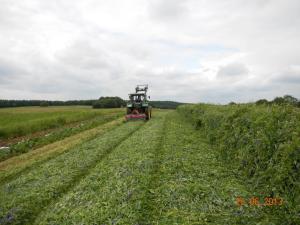It sounds like there was a great turnout for Jan’s eOrganic webinar on the cut-and-carry mulch system he and his colleagues are using for organic vegetable production in Germany. My favorite quote:
“You can completely screw up the system and do a lot of things wrong.” – Jan-Hendrik Cropp
Don’t let that deter you!
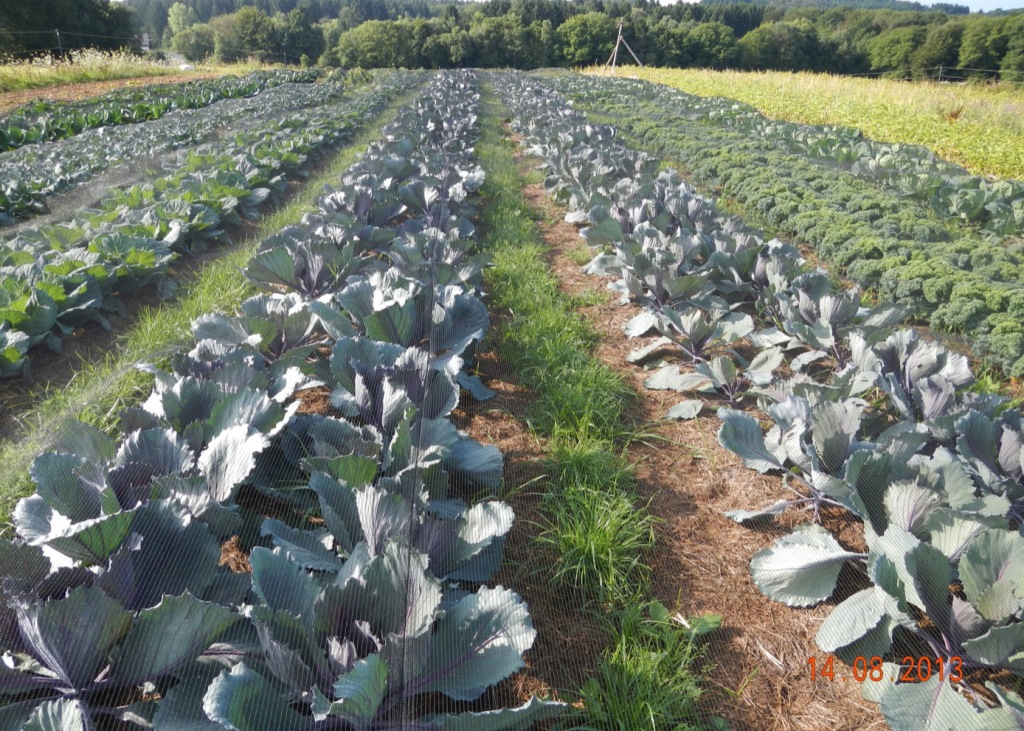
Cabbage grown in a transferred mulch system in Germany. The grass in the paths was intentionally planted. Photo: Jan-Hendrik Cropp
Rather than summarize the webinar here (you really should watch it in its entirety if you’re interested), I have attempted to address some of the questions raised regarding the economics of rotations like this and the use of silage as mulch.
The production of mulch
Jan’s system uses large amounts of mulch for transplanted organic vegetable crops. The mulch is grown in two ways: in situ as high-residue cover crops (they like the triticale, hairy vetch, fava bean, and Austrian winter pea mix), and in separate fields (leys) of clover-grass pasture mix. (There were many people who had questions about the species in the clover-grass mix. I have included the list of species in the mix at the end of this post). The clover-grass mulch is used where there was not an overwintering high biomass cover crop OR where the overwintering high biomass cover crop did not perform adequately to provide a weed-suppressing mulch on its own.
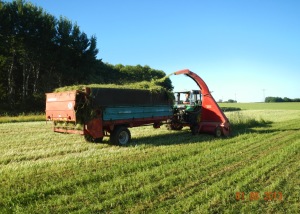
The clover-grass leys are chopped and loaded onto a manure spreader, then spread on the vegetable fields before transplanting. Photo: Jan-Hendrik Cropp.
The first cut of the clover-grass is chopped and transferred directly to the vegetable fields prior to transplanting in May or June. The second and third cuts are preserved as silage and then transferred the following year as mulch prior to vegetable transplating. In addition to providing mulch, the inclusion of the clover-grass leys in the rotation serve as a sod crop to improve soil structure and increase soil organic matter in those areas (for more on rotations for better soil health, see Building Soils for Better Crops). Despite the soil quality improvements in the system Jan and his colleagues use, questions emerged about the amount of land, time, and equipment needed. The clover-grass ley takes approximately the same amount of land as the vegetable fields, and making silage seems like a chore most vegetable farmers don’t have time to tackle. How can this system be economical?
Opportunity costs of cover crops
The economics of cover cropping (and this is a form of cover cropping) are complicated. Selling cash crops ideally produces a tangible (monetary) return, but cover crops have less obvious short-term monetary returns. Some benefits like weed suppression may be felt immediately, but others may become apparent only after many years. Similarly, the detrimental effects of high-intensity tillage systems may be noticed immediately when an erosion gully forms, or may take years to manifest themselves as soil health slowly but steadily declines.
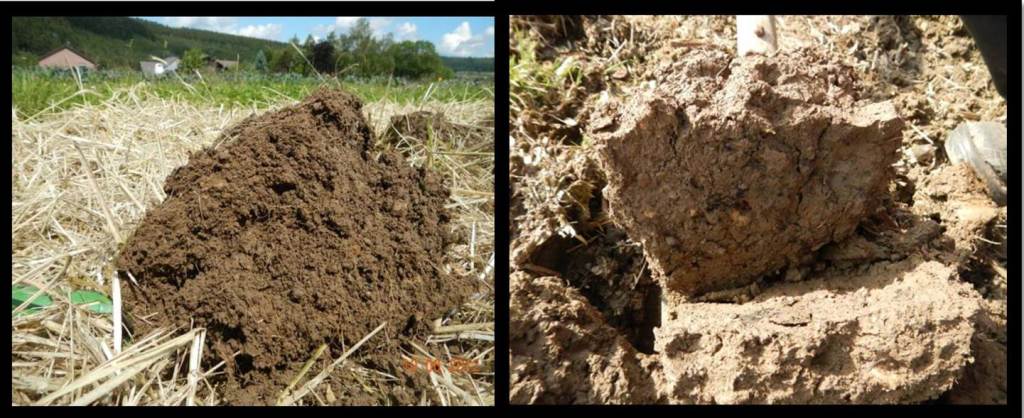
Soil structure can benefit from practices like mulching and cover crops (left), and can be harmed by practices like tillage (right). Photo: Jan-Hendrik Cropp.
I am familiar with the economic conundrum. When I talk about growing a forage radish cover crop in fall for no-till vegetable production the following spring, questions are always raised about the opportunity cost of planting a cover crop in August when another quick cash crop could easily be grown in that period. How do you value the agro-ecosystem services of a cover crop or sod crop in rotation? In an article comparing enterprise budgets between two organic farms, Conner and Rangarajan (2009) note that:
Ideally, the opportunity cost [of cover cropping] would be the difference between foregone revenue from potential cash crop sales and the value of the various services provided.
But, for the most part, data are not available on the value of the “various services provided” and such an analysis would require long-term records on soil health metrics in addition to the usual categories included in an enterprise budget. Hence, they are left out of many economic analyses of farming systems.
There are benefits to dedicating time and land to growing cover crops. Whether they add up to be more than the foregone revenue from not growing more cash crops is for each farmer to determine.
Personal preferences and thinking of the whole system
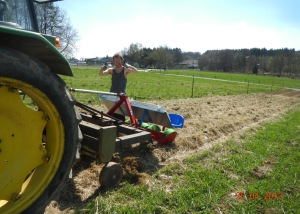
Jan likes the mulch and the high-residue transplanter. Personal preference makes a difference in farming choices.
Economics are essential, but personal likes and dislikes should also be considered. In a system like Jan’s transfer mulch system, labor is shifted away from weeding, fertilizing, and irrigating in the peak of the summer—the mulch essentially takes care of these aspects—to chopping and ensiling mulch. Which would you rather do? That’s an honest question—not a value judgment!
A perfect example of the intersection of economics and personal preference is the contrast between the two farms featured in Connor and Rangajaran’s analysis. A desire to minimize outside labor and external inputs has led the Nordells at Beech Grove Farm to maintain 50% of their production acres as cover crops/fallow in any given year whereas the Brownbacks at Spiral Path Farm hire a large crew, keep nearly all their acres in cash crop production every year, and sustain their soil organic matter with mushroom compost additions. The point it, there are wide-ranging management practices, and preference should be a driving factor in some decisions. Managing high-residue cover crops and transfer-mulch systems like Jan’s requires certain preferences, in addition to the skills, equipment, and land required.
Silage as mulch?
Silage, or haylage, is generally considered animal feed. Think of it as sauerkraut for cows. Plant material is naturally fermented in anaerobic conditions, driving down the pH of the material. The bulk of the nutrients are preserved with this method, though there is a change in the composition as sugars are converted to lactic acid. Instead of feeding it to cows, Jan and colleagues bypass the animal digestion and put it directly back on the field as mulch.
Livestock farmers might be thinking “why would you not feed silage to an animal?” and vegetable farmers might be thinking “silage making sounds very complicated, why would I want to do that?” In a more diversified farm, you could feed this silage to cows. Or you could use the first cut as a transfer mulch, then skip the second and third cuts and instead graze it. Or you could make hay. All of these options would further reduce the ratio of mulch growing land to vegetable land, but you would reap different benefits. Again, these decisions are best made individually for a particular farm and farmer.
One thing to note about the use of silage as mulch vs. fresh chopped clover-grass is that because of the changes in composition during the ensiling process, silage mulch may have different effects on soil nutrient dynamics than fresh clover-grass mulch. Moritz Hallama, one of Jan’s colleagues, wrote his M.S. thesis on the use of fresh and ensiled mulch for potato production. His data suggest that fresh mulch may provide an early increase in soil mineral N compared to ensiled mulch. If this is indeed the case, fresh cut clover-grass should be reserved for crops with earlier peak N demands, whereas silage mulch should be used on crops that have a later peak N demand. Plants may access nutrients directly from the mulch in addition to from the soil, so the nutrient story may be even more complex.
The take away
The system Jan and colleagues have been working on combines short and long-term goals: to grow high-yielding vegetable crops with minimal external inputs, and to increase soil health. But it requires a whole systems change, including the investment in equipment that most vegetable farmers don’t currently have, and the dedication of significant portions of land to mulch-growing, soil-building crops. Nonetheless, they’ve shown that it can be done on a commercial scale in Germany, and I think we will continue to hear of their ongoing research and equipment innovations. Thanks to Jan and his colleagues for sharing, and let’s keep this conversation going.
To get in touch with Jan directly, visit their website.
Species list: According to Moritz Hallama’s M.S. thesis, the species in the clover grass mix were: 30% legumes: [Melilotus officianalis (yellow sweet clover), Medicaga sativa (alfalfa), Medicago lupina (black medic), Trifolium repens (white clover), Trifolium pretense (red clover), Trifolium hybridum (alsike clover)]; 60% grasses: [(Festuca arundinacea (tall fescue), F. rubra (red fescue), lolium perenne (perennial ryegrass)]; and 10% herbaceous plants: [Sanguisorba minor (small burnet), Pastinaca sativa (wild parsnip), Lomatium foeniculaceum (desert biscuitroot), Plantago lanceolata (plantain), Carum carvi (caraway), Cichorium intybus (chicory), Achillea sp. (yarrow), and Pimpinella saxifrage (burnet-saxifrage).

